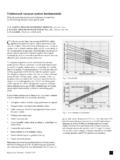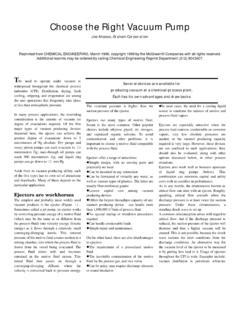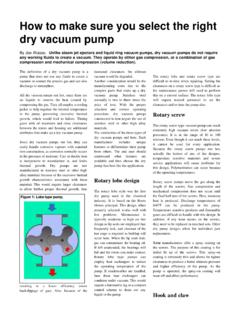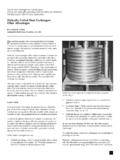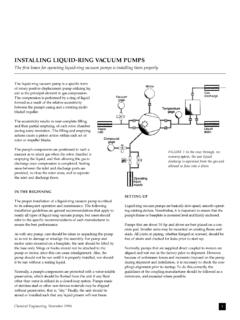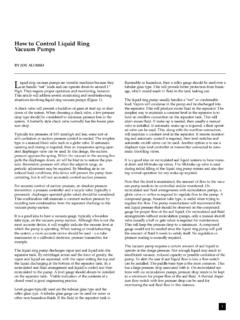Transcription of Ejector system troubleshooting - Graham
1 First published in The International Journal of Hydrocarbon Engineering, UK, 1997 IntroductionWhether for lube oil, fuel oil, or general fractionation,vacuum columns utilize Ejector systems to maintaindesign vacuum levels within the , cracked gases, hydrocarbon vaporsand steam are removed from the column by the ejectorsystem. Extraction of these fluids from the column is key toa proper vacuum level within the column and consequently,design charge rates and specification quality product do have lengthy operating experience with ejectorsystems. Ejector systems have been the mainstay forrefinery vacuum distillation.
2 Whether a crude vacuum toweroperates as a wet , damp or dry tower, an ejectorsystem is the vacuum producer. Different tower operatingpressures and overhead load characteristics of wet, dampor dry operation affect only the configuration of an ejectorsystem but the basic operating principle with lengthy operating experience, refiners viewejector systems with hesitation and uncertainty. Thisuncertainty results from an incomplete understanding ofthe basic operating principles of ejectors themselves andtheir interdependency with any vacuum condenser itsupports or to which it discharges. There is only limitedinformation in technical journals or books addressingoperating principles of Ejector systems.
3 On a positive note, Ejector systems are quite reliable and performanceshortcomings are not a common problem. However, whenoperating problems do occur, they appear as a dramaticchange in performance rather than a gradual loss ofperformance. Vacuum tower crisis is always critical and animmediate remedy is necessary. The purpose of thisarticle is to offer a concise and complete overview ofejector and condenser fundamentals, system operationand partsIt is important to know the proper nomenclature for internalparts of an Ejector before beginning to discuss how anejector works. An Ejector is a static piece of equipment withno moving parts (Figure 2).
4 There are four majorcomponents to an Ejector , the motive nozzle, motive chest,suction chamber and system troubleshootingJ. R. Lines and R. T. Smith, Graham Corporation examineejector systems and provide troubleshooting experiencewith reference to case 1. Three stage twin element Ejector systemOperating principleThe basic operating principle of an Ejector is to convertpressure energy of high pressure motive steam into velocity steam emitted from a motive nozzle is then usedto work on the suction fluid. This work occurs in the suctionchamber and diffuser inlet. The remaining velocity energy isthen turned back into pressure across the diffuser.
5 In simpleterms, high pressure motive steam is used to increase thepressure of a fluid that is at a pressure well below motivesteam , high velocity is achieved through adiabaticexpansion of motive steam across the converging/divergingmotive nozzle from motive pressure to suction fluid operatingpressure. The expansion of the steam across the motive nozzleresults in supersonic velocities at the nozzle exit. Typically,velocity exiting a motive nozzle is in the range of Mach 3 to 4,which is 3000 to 4000 ft/sec. In actuality, motive steam expandsto a pressure below the suction fluid pressure. This creates thedriving force to bring suction fluid into an Ejector .
6 High velocitymotive steam entrains and mixes with the suction fluid. Theresulting mixture is still supersonic. As this mixture passesthrough the converging, throat, and diverging sections of adiffuser, high velocity is converted back into pressure. Theconverging section of a diffuser reduces velocity as the cross-sectional area is reduced. The diffuser throat is designed tocreate a normal shock wave. A dramatic increase in pressureoccurs as flow across the shock wave goes from supersonic, tosonic at the shock-wave, to subsonic after the shock wave. In adiffuser diverging section, cross-sectional flow area isincreased and velocity is further reduced and converted performance curveEjector manufacturers summarize critical dataon a performance curve.
7 Figure 3 shows aperformance curve for a single stage the y-axis of this curve is suction pressurein millimeters of mercury absolute (mm HgA).On the x-axis is the water vapor equivalent load(Ib/hr).Equivalent load is used to express a processstream, which may be made up of manydifferent components, such as air, water vaporand hydrocarbons, in terms of an equivalentamount of water vapor load. Figures 4 and 5,from the Heat Exchange Institute Standards forJet Vacuum Systems, show the curves that areused to convert various molecular weightgases to the appropriate vapor equivalent at areference temperature of 70 performance curve can be used in twoways.
8 First, if the suction pressure is known foran Ejector , the equivalent vapor load it handlesmay be determined. Secondly, if the loading toan Ejector is known, suction pressure can bedetermined. If field measurements differ froma performance curve, then there may be aproblem with either the process, utilities steamMinimum motive steam pressure is importantand is also shown on a performance manufacturer has designed the system tomaintain stable operation with steampressures at or above a minimum steampressure. If motive steam supply pressure fallsbelow design, then a motive nozzle will passless steam. When this happens, the Ejector isnot provided with sufficient energy to compressthe suction fluid to the design dischargepressure.
9 The same problem occurs when thesupply motive steam temperature rises aboveits design value, resulting in increased specific volume,and consequently, less steam passes through the Ejector may operate unstably if it is not supplied withsufficient energy to allow compression to its designdischarge pressure. Unstable Ejector operation ischaracterized by dramatic fluctuations in operatingpressure. If the actual motive steam pressure is belowdesign or its temperature above design, then, within limits,an Ejector nozzle can be rebored to a larger diameter. Thelarger nozzle diameter allows more steam to flow throughand expand across the nozzle.
10 This increases the energyavailable for compression. If motive steam supplypressure is more than 20 - 30% above design, then toomuch steam expands across the nozzle. This tends tochoke the diffuser. When this occurs, less suction load ishandled by the Ejector and suction pressure tends to an increase in suction pressure is not desired, thenejector nozzles must be replaced with ones having smallerthroat diameters or the steam pressure quality is another important performance steam may be damaging to an Ejector droplets in motive steam lines are accelerated tohigh velocities and become very erosive.



